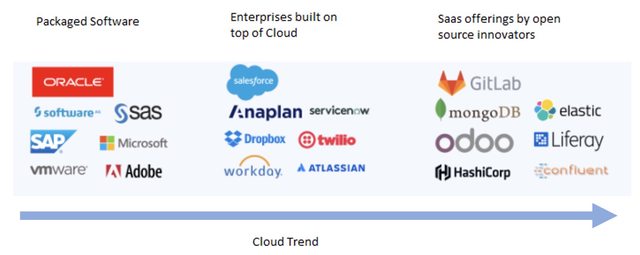Before 2005, most of the technology was open source and enterprises were consuming open source to accomplish their business goals and the trend seems to continue to grow. Take the operating system as an example. The use and popularity of Linux have been growing day by day. Another good example is the database industry where MySQL and Postgres are rapidly growing over time as opposed to Oracle or Microsoft’s SQL Server.
The open-source trend was not surprising as proprietary technology leads to lock-ins and as these enterprises grow, their reliance on these foundational pieces continues to grow over time. This makes it really difficult and costly for these enterprises to switch to new technology, locking them into the closed-source technology and leaving them vulnerable to hefty prices or punitive charges as they scale. This drove many enterprises to come together and join hands to collectively build different open-source components.
The use of open source technology freed enterprises from potential lock-ins but led to other challenges. One of the main challenges with open source was enterprises needing a dedicated team to manage the technology over time in order to customize them, to upgrade them, to extend them for better usability or observability or auditing, etc. Human resource is one of the most expensive resources and spinning a team up for every open-source software is not scalable. As a result, enterprises started abstracting the class of these technologies within their corporation by having dedicated teams manage them.
Many enterprises started embracing this new model and it still exists in many enterprises but it was still not efficient for many reasons. First, the optimization to batch different related technologies makes sense but it is still not sufficient. Look at it this way, every enterprise has to learn about operating different classes of technology at scale and have a team to maintain them. Amazon realized the same and saw the potential of externalizing these learnings by offering a managed service to other enterprises in the world, which led to the evolution of Cloud through AWS (short for Amazon Web Services). Soon after, many other providers emerged from Azure Cloud to Alibaba Cloud.
The emergence of the Cloud really allowed these enterprises to not only manage these open source technologies by themselves and instead focus on their core technology by offloading some of these components to cloud providers without any lock-ins. The other advantage was that these enterprises don’t have to buy/set up data centers throughout the globe, a huge advantage to startups for not requiring upfront costs and time commitment. It’s not surprising most modern-day startups are built on top of the Cloud. Is that it? Have we reached the final nirvana state? Is the future of open-source in the hands of the Cloud?
The rise of the Cloud led to its own challenges:
- vendor lock-in instead of software lock-in
- control on sensitive data
- resiliency.
We are seeing a shift by CIOs/CTOs to increasingly deploy multi-cloud and hybrid-cloud strategies as a result. In fact, there are startups like Aiven that are making it easy to adopt multi-cloud strategies for enterprises. For sensitive data, there is a trend by different public cloud providers to provide better integration with their customer's on-prem datacenter or partnerships with private cloud providers.
All these innovations led to a shift from enterprises buying packaged software to enterprises being built on the cloud. Going forward, we are noticing that open-source innovators are offering their own cloud-native multi-cloud offerings and we believe that there will be hundreds of such providers offering Paas/Saas solutions while AWS/Azure/GCP will become more of infrastructure providers. The below diagram captures it all:

What other shifts did you notice?